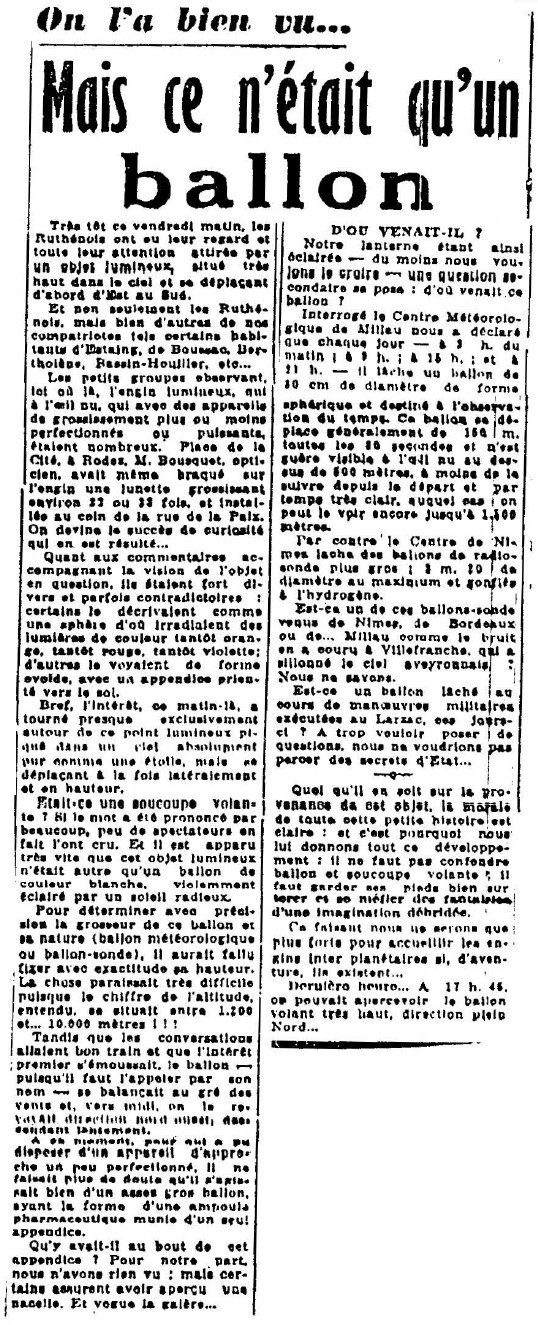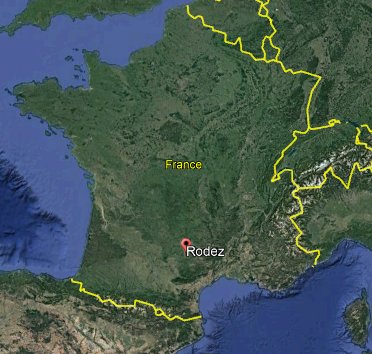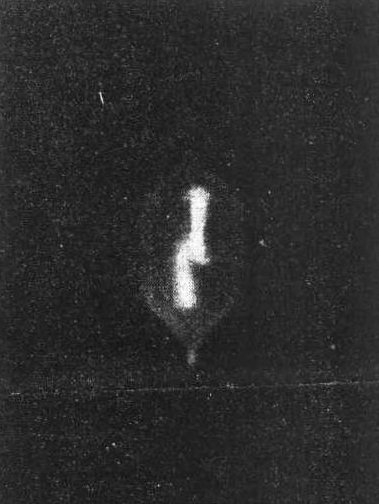
The index page for the 1954 French flap section of this website is here.
Reference for this case: 15-Oct-54-Rodez.
Please cite this reference in any correspondence with me regarding this case.
The ufology bulletin Vaucluse Ufologie #18-19 of June - September 1980, reproduced an article, indicated to come from the regional newspaper Le Midi Libre for October 16, 1954, reporting that the observations of October 15, 1954 in the South-East of France were in fact not those of a flying saucer, but those of "sounding balloons of the Italian meteorological services", from the Milan Institute, with a diameter of 28 meters, capable of reaching an altitude of 50,000 meters and carrying in its nacelle devices for the study of cosmic rays.
Among the sightings mentioned, there had been one at dawn in Rodez, of a "mysterious craft which changed shapes and colors several times", which was visible until 11 a.m., and "disappeared towards the South."
The regional newspaper Le Rouergue Républicain of the same October 16, 1954, told more about the observation of what "was only a balloon", of which they were unable to find the origin:
Very early this Friday morning, the Ruthenians [i.e. residents of Rodez] had their eyes and all their attention attracted by a luminous object, located very high in the sky and moving initially from East to South.
Not only the Ruthenians, but many others of our compatriots, such as some inhabitants of Estain, Boussac, Bertholene, Bassin-Houiller, etc.
The small groups observing, here and there, the luminous machine, some with the naked eye, some with more or less perfected or powerful magnification apparatus, were numerous. Place de la cité, in Rodez, Mr. Bousquet, an optician, had even pointed a telescope of a power of about 22 or 23 times on the apparatus, and installed it at the corner of the Rue de la Paix. We can guess the success of curiosity that resulted from it...
As for the comments accompanying the vision of the object in question, they were very diverse and sometimes contradictory: some described it as a sphere from which lights of color sometimes orange, sometimes red, sometimes purple irradiated; others saw it with an ovoid shape, with an appendage pointing towards the ground.
In short, the interest that morning turned almost exclusively around that luminous point stitched into an absolutely pure sky like a star, but moving both laterally and in height.
Was it a flying saucer? If the word was said by many, few spectators actually believed it. And it soon appeared that this luminous object was nothing but a balloon of a white color, violently illuminated by a radiant sun.
To determine accurately the size of this balloon and its nature (weather balloon or sounding balloon), it would have been necessary to determine its height accurately. This seemed very difficult since the number of the altitude heard, was between 1,200 and... 10,000 meters!!!
While the conversations were going on and the first interest was blunted, the balloon - as it has to be called by its name - swung as the wind blew, and by noon it was heading northwest, descending slowly.
At this time, for those who had access to a somewhat sophisticated magnification device, there was no longer any doubt that it was indeed a rather large balloon, in the form of a pharmaceutical ampule provided with a single appendix.
What was there at the end of this appendage? For our part, we saw nothing; but some assure to have seen a nacelle. And sails the galley...
WHERE DID IT COME FROM?
Our lantern being thus enlightened - at least we want to believe it - a secondary question arises: where did this balloon come from?
When questioned, the Meteorological Center of Millau told us that every day - at 3 in the morning; at 9 o'clock.; at 3 p.m.; and at 9 p.m. - they launch a 80 cm diameter balloon of spherical shape intended for observation of the weather. This balloon generally travels 150 meters every 30 seconds and is hardly visible to the naked eye above 500 meters, unless you follow it from the start and in very clear weather, in which case you can still see it up to 1,500 meters.
On the other hand, the Center de Nîmes launches bigger radio-sounding balloons: 3.20 m. of maximum diameter and inflated with hydrogen.
Is it one of these sounding-balloons coming from Nimes, Bordeaux, or... Millau, like the rumor from Villefranche sais, that traveled across the Aveyron sky? We do not know.
Is it a balloon dropped during military maneuvers executed at the Larzac these days? We do not wish to breach state secrets by asking too many questions...
Whatever may be the origin of this object, the moral of this little story is clear; and that is why we give it all this development: we must not confuse balloons and flying saucers! We must keep our feet firmly on the ground and be wary of the fantasies of an unbridled imagination.
In doing so, we will only be stronger to welcome inter-planetary craft if, by chance, they exist...
Last minute... At 5:45 p.m, one could see the balloon flying very high, heading north...
[Ref. vue1:] UFOLOGY BULLETIN "VAUCLUSE UFOLOGIE":
Paris October 15 - The Saucer psychosis continues to develop, bringing more negative elements than positive details. And there is soon not a corner of France that cannot claim to have been flown over by some unknown machine, coming from who knows where.
Aveyron and Lozère have also known the "Saucers" since this morning.
In Rodez, it was at dawn that a mysterious craft which changed shapes and colors several times, could be spotted. It moved in this manner until the stroke of eleven o'clock, to disappear in the direction of the South.
We learned in the evening that it was a sounding balloon from the Italian Meteorological Services, from the MILAN Institute. This balloon with a diameter of 28 meters, would be likely to reach an altitude of 50,000 meters. It would include, in its nacelle, devices intended for the study of cosmic rays.
Thursday afternoon, a craft resembling a large star was seen successively in the Briançonnais sky, the Hte-Tarentaise, the valley of Albertville and the region of Chambery.
It was actually a sounding balloon from the Milan region.
Around 5 p.m., workers working on a construction site, about fifteen kilometers from Briançon, recovered the scientific devices from this balloon and handed them over to the Gendarmerie. As for the craft, it continued its route in the direction of Gap, in the evening.
In Avignon, the alert must have been hotter. Around 11 a.m., the secretary of the town hall of Fontaine-de-Vaucluse telephoned the Orange air base to report, among other things, a "Saucer", at the vertical of his town hall. The details were such that the leader of one of the squadrons telephoned the mayor of Fontaine.
The latter, not only confirmed the indications of his secretary, but specified that the Saucer remained motionless 400 meters vertically from the locality.
2 pilots who were taking off for a training flight flew over Fontaine de Vaucluse a few moments later without spotting the slightest Saucer.
In the evening, the Secretary of State for Air indicated that the two airmen from the Orange base, "experienced officers", had not observed any unknown craft during their research and that their report was formal.
It was, again, a sounding balloon, used by the Meteorological Services.
MIDI LIBRE for Saturday OCTOBER 16, 1954 - #3412 -
[...]
The Midi Libre articles reproduced here were sent to us by our friend Daniel Vidal. They illustrate in a precise manner the enormous work of archive research carried out by Daniel. An example to follow that should be taken up systematically in each region.
[Ref. lrr1:] NEWSPAPER "LE ROUERGUE REPUBLICAIN":

|
Very early this Friday morning, the Ruthenians [i.e. residents of Rodez] had their eyes and all their attention attracted by a luminous object, located very high in the sky and moving initially from East to South.
Not only the Ruthenians, but many others of our compatriots, such as some inhabitants of Estain, Boussac, Bertholene, Bassin-Houiller, etc.
The small groups observing, here and there, the luminous machine, some with the naked eye, some with more or less perfected or powerful magnification apparatus, were numerous. Place de la cité, in Rodez, Mr. Bousquet, an optician, had even pointed a telescope of a power of about 22 or 23 times on the apparatus, and installed it at the corner of the Rue de la Paix. We can guess the success of curiosity that resulted from it...
As for the comments accompanying the vision of the object in question, they were very diverse and sometimes contradictory: some described it as a sphere from which lights of color sometimes orange, sometimes red, sometimes purple irradiated; others saw it with an ovoid shape, with an appendage pointing towards the ground.
In short, the interest that morning turned almost exclusively around that luminous point stitched into an absolutely pure sky like a star, but moving both laterally and in height.
Was it a flying saucer? If the word was said by many, few spectators actually believed it. And it soon appeared that this luminous object was nothing but a balloon of a white color, violently illuminated by a radiant sun.
To determine accurately the size of this balloon and its nature (weather balloon or sounding balloon), it would have been necessary to determine its height accurately. This seemed very difficult since the number of the altitude heard, was between 1,200 and... 10,000 meters!!!
While the conversations were going on and the first interest was blunted, the balloon - as it has to be called by its name - swung as the wind blew, and by noon it was heading northwest, descending slowly.
At this time, for those who had access to a somewhat sophisticated magnification device, there was no longer any doubt that it was indeed a rather large balloon, in the form of a pharmaceutical ampule provided with a single appendix.
What was there at the end of this appendage? For our part, we saw nothing; but some assure to have seen a nacelle. And sails the galley...
Our lantern being thus enlightened - at least we want to believe it - a secondary question arises: where did this balloon come from?
When questioned, the Meteorological Center of Millau told us that every day - at 3 in the morning; at 9 o'clock.; at 3 p.m.; and at 9 p.m. - they launch a 80 cm diameter balloon of spherical shape intended for observation of the weather. This balloon generally travels 150 meters every 30 seconds and is hardly visible to the naked eye above 500 meters, unless you follow it from the start and in very clear weather, in which case you can still see it up to 1,500 meters.
On the other hand, the Center de Nîmes launches bigger radio-sounding balloons: 3.20 m. of maximum diameter and inflated with hydrogen.
Is it one of these sounding-balloons coming from Nimes, Bordeaux, or... Millau, like the rumor from Villefranche sais, that traveled across the Aveyron sky? We do not know.
Is it a balloon dropped during military maneuvers executed at the Larzac these days? We do not wish to breach state secrets by asking too many questions...
Whatever may be the origin of this object, the moral of this little story is clear; and that is why we give it all this development: we must not confuse balloons and flying saucers! We must keep our feet firmly on the ground and be wary of the fantasies of an unbridled imagination.
In doing so, we will only be stronger to welcome inter-planetary craft if, by chance, they exist...
Last minute... At 5:45 p.m, one could see the balloon flying very high, heading north...

|
The high altitude balloon of the University of Padua that day.
One or more stratospheric balloons to study cosmic rays were launched from Milan, Italy, as a project of the Padova University, and floated in the French sky on October 14, 15 and 16, 1954; this photograph was taken from the observatory of Haute-Provence:

|
See here the 1968 note about it from Raymond Veillith, and that of Aimé Michel in 1958.
(These keywords are only to help queries and are not implying anything.)
Rodez, Aveyron, multiple, telescope, binocular, ball, balloon, white, orange, red, purple, slow, appendage, negative case, craft, changes, duration, direction
[----] indicates sources that are not yet available to me.
| Version: | Created/Changed by: | Date: | Change Description: |
|---|---|---|---|
| 1.0 | Patrick Gross | March 1, 2017 | First published. |
| 1.1 | Patrick Gross | May 16, 2022 | Addition [vue1], Summary. |